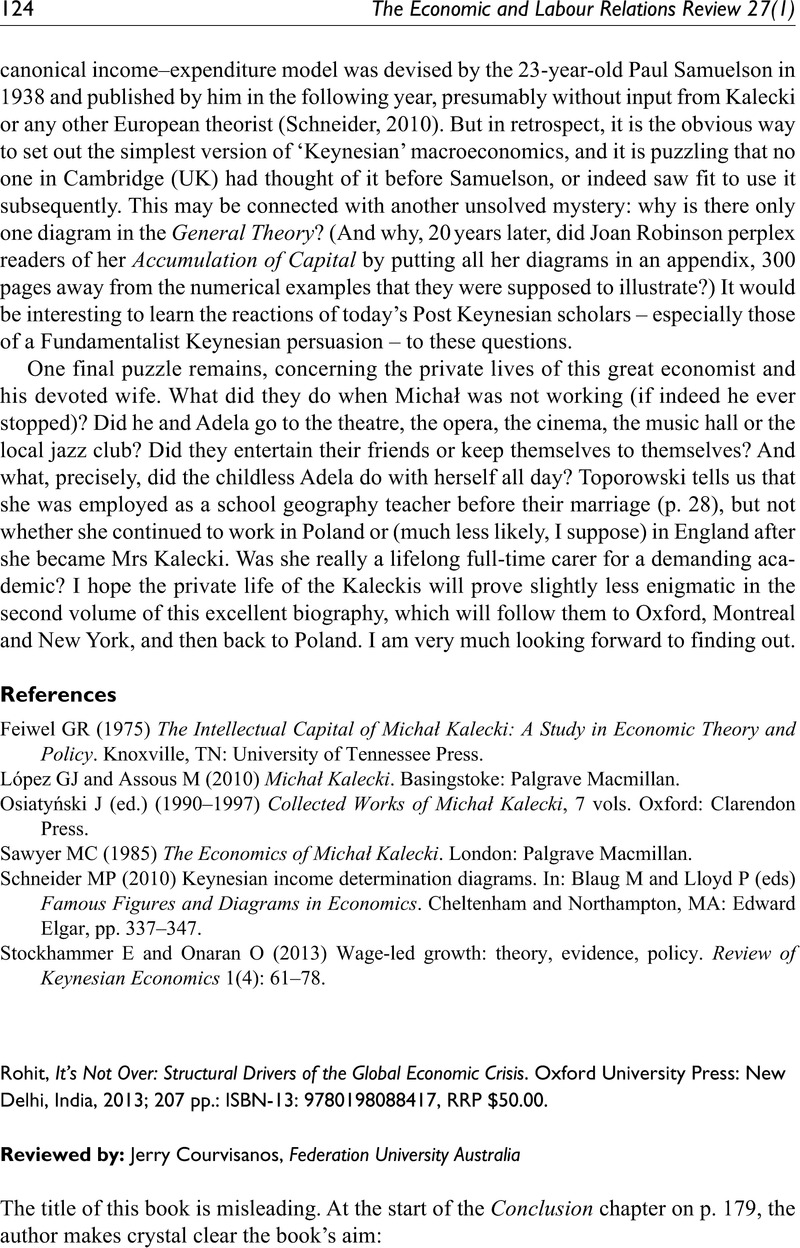No CrossRef data available.
Article contents
Rohit, It’s Not Over: Structural Drivers of the Global Economic Crisis. Oxford University Press: New Delhi, India, 2013; 207 pp.: ISBN-13: 9780198088417, RRP $50.00.
Review products
Rohit, It’s Not Over: Structural Drivers of the Global Economic Crisis. Oxford University Press: New Delhi, India, 2013; 207 pp.: ISBN-13: 9780198088417, RRP $50.00.
Published online by Cambridge University Press: 01 January 2023
Abstract
An abstract is not available for this content so a preview has been provided. Please use the Get access link above for information on how to access this content.

- Type
- Book reviews
- Information
- Copyright
- © The Author(s) 2016
References
Acs, ZJ, Audretsch, DB
(2005) Entrepreneurship, Innovation and Technological Change. Delft: now Publishers.CrossRefGoogle Scholar
Arestis, P, Sawyer, M
(2015) Austerity cannot explain the current UK economic growth. Challenge 58(2): 149–159.CrossRefGoogle Scholar
Bhaduri, A, Steindl, J
([1983] 1985) The rise of monetarism as a social doctrine. In:
Arestis, P, Skouras, T
(eds) Post Keynesian Theory: A Challenge to Neo-Classical Economics. Brighton: Wheatsheaf Books, pp. 56–78 (originally published 1983, Thames Papers in Political Economy, Autumn, pp. 1–18).Google Scholar
Botta, A
(2015) The complex inequality-innovation-public investment nexus. Greenwich Papers in Political Economy, No. GPERC13. University of Greenwich. Available at: http://gala.gre.ac.uk/14064/1/GPERC13_BottaF.pdf (accessed 15 January 2015).Google Scholar
Courvisanos, J
(2012) Cycles, Crises and Innovation Path to Sustainable Development – A Kaleckian-Schumpeterian Synthesis. Cheltenham: Edward Elgar.Google Scholar
Hein, E
(2012) The Macroeconomics of Finance-Dominated Capitalism – And Its Crisis. Cheltenham: Edward Elgar.CrossRefGoogle Scholar
Keen, S
(2013) A monetary Minsky model of the Great Moderation and the Great Recession. Journal of Economic Behavior and Organization 86: 221–235.Google Scholar
Krugman, P
(2009) The Return of Depression Economics and the Crisis of 2008. New York: W.W. Norton & Company.Google Scholar
Mazzucato, M
(2013) The Entrepreneurial State: Debunking Public vs. Private Sector Myths. London: Anthem Press.Google Scholar
Steindl, J
(1979) Stagnation theory and stagnation policy. Cambridge Journal of Economics 3(1): 1–14.Google Scholar
Stiglitz, J
(2010) Freefall: America, Free Markets, and the Sinking of the World Economy. New York: W.W. Norton & Company.Google Scholar
Van Dijk, B, Den Hertog, R, Menkveld, B and Thurik R
(1997) Some new evidence on the determinants of large- and small-firm innovation. Small Business Economics 9(4): 335–343.CrossRefGoogle Scholar
Wray, LR
(2013) The global financial crisis: lessons we should have learned and an agenda for reform. In:
Dasgupta, B
(ed.) Non-Mainstream Dimensions of Global Political Economy. Milton Park: Routledge, pp. 23–44.Google Scholar


